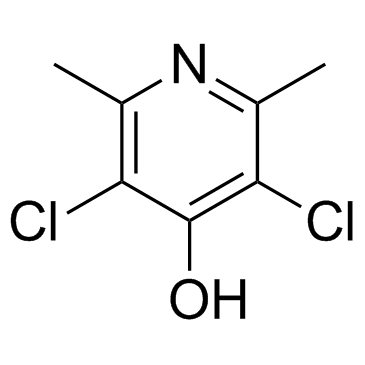Clopidol

Clopidol structure
|
Common Name | Clopidol | ||
|---|---|---|---|---|
| CAS Number | 2971-90-6 | Molecular Weight | 192.043 | |
| Density | 1.4±0.1 g/cm3 | Boiling Point | 318.4±37.0 °C at 760 mmHg | |
| Molecular Formula | C7H7Cl2NO | Melting Point | >320℃ | |
| MSDS | Chinese USA | Flash Point | 146.4±26.5 °C | |
| Symbol |

GHS07 |
Signal Word | Warning | |
|
Determination of residual clopidol in chicken muscle by capillary gas chromatography/mass spectrometry.
J. AOAC Int. 88(4) , 1104-7, (2005) Clopidol was extracted from chicken with acetonitrile, and the extract was evaporated to about 5 mL. The concentrated solution was centrifuged and applied to a glass column filled with basic alumina. The column was eluted with methanol and the methanol was ev... |
|
|
Efficacy of selected oral chemotherapeutants against Ichthyophthirius multifiliis (Ciliophora: Ophyroglenidae) infecting rainbow trout Oncorhynchus mykiss.
Dis. Aquat. Organ. 55(1) , 17-22, (2003) The chemotherapeutic efficacy of 6 in-feed compounds against Ichthyophthirius multifiliis Fouquet, 1876 was assessed using experimental infections of rainbow trout Oncorhynchus mykiss (Walbaum) fingerlings. Trial doses of 104 ppm amprolium hydrochloride or 65... |
|
|
Incidence, predictors and outcome of drug-eluting stent thrombosis in real-world practice.
J. Invasive Cardiol. 22(10) , 461-4, (2010) Traditionally, stent thrombosis (STH) has been regarded as a complication of percutaneous coronary interventions during the first 30 post-procedural days. However, delayed endothelialization associated with the implantation of drug-eluting stents (DES) may ex... |
|
|
Determination of clopidol residues in chicken tissues by liquid chromatography: part III. Quality control analysis of export chickens.
J. AOAC Int. 84(5) , 1347-51, (2001) A summary is presented of the liquid chromatographic (LC) determination of clopidol residues in export chickens from 1992 to 1999. Over the past 8 years, we analyzed >7000 chicken samples. A total of 0.66% of samples contained clopidol residues, ranging from ... |
|
|
Determination of clopidol residues in chicken tissues by liquid chromatography: part II. Distribution and depletion of clopidol in chicken tissues.
J. AOAC Int. 84(5) , 1343-6, (2001) A study was made of the distribution and depletion of clopidol residues at different tissue locations in chickens fed with feeds incurred with clopidol. Experiments showed that the residue levels were not identical at 5 different tissue locations in each chic... |
|
|
Determination of clopidol residues in chicken tissues by liquid chromatography: part I. Optimization of analytical conditions and comparison with AOAC gas chromatography method.
J. AOAC Int. 84(5) , 1337-42, (2001) A simple and specific liquid chromatographic method was developed for determination of clopidol in chicken tissues. Samples were extracted with acetonitrile. The extracts were cleaned up on an alumina column and an anion exchange column. The clopidol was sepa... |
|
|
Determination of clopidol residues in chicken tissues by liquid chromatography: collaborative study.
J. AOAC Int. 86(4) , 685-93, (2003) Eighteen laboratories participated in a collaborative study on the determination of clopidol residues in chicken muscle tissues by liquid chromatography. Of these, results from 16 laboratories which rigorously followed the method were subjected to statistical... |
|
|
Committee on drugs and related topics. Drug residues in animal tissues.
J. AOAC Int. 86(1) , 116-27, (2003)
|
|
|
Determination of residual clopidol in chicken muscle by capillary gas chromatography-negative chemical ionization-mass spectrometry.
Anal. Sci. 25(10) , 1203-6, (2009) A selective, sensitive gas chromatography-mass spectrometry (GC-MS) method with negative chemical ionization (NCI) was developed for the detection and quantification of clopidol in chicken muscle. Chicken muscle samples were extracted with acetonitrile and co... |
|
|
Effect of clopidogrel on platelet aggregation and plasma concentration of fibrinogen in subjects with cerebral or coronary atherosclerotic disease.
Clin. Appl. Thromb. Hemost. 8(2) , 169-77, (2002) Acetylsalicylic acid inhibits thromboxane A2 production and reduces the risk of vascular occlusive events by 20% to 25%. Ticlopidine inhibits ADP-dependent platelet aggregation and reduces the same risk by 30% to 35%, but produces some adverse effects. Clopid... |